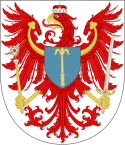Jan I Askańczyk
| ||||
 | ||||
| margrabia Brandenburgii-Stendal | ||||
| Okres | ||||
|---|---|---|---|---|
| Następca | ||||
| Dane biograficzne | ||||
| Dynastia | ||||
| Data urodzenia | ||||
| Data śmierci | ||||
| Ojciec | ||||
| Matka | Mechtylda (Matylda) | |||
| Żona | Zofia | |||
| Dzieci | Jan II | |||
Jan I Askańczyk (ur. 1213, zm. 10 września 1266) – margrabia brandenburski, założyciel Gorzowa (nm. Landsberg), syn Albrechta II, brat m.in. Ottona III, założyciel starszej linii askańskiej, zwanej joannicką.
W 1224 jako małoletni pozostawał wraz z bratem pod opieką Heinricha, hrabiego v. Anhalt, na zjeździe Rzeszy we wrześniu 1231 obaj otrzymali od cesarza Fryderyka II w lenno Marchię Brandenburską z księstwem pomorskim, 2 lipca 1257 w Stolpe wystawił przywilej lokacyjny miasta Landisberch nova, tuż przed śmiercią 3 marca 1266, przeprowadził z bratem podział Marchii Brandenburskiej: Nowa Marchia wraz z Gorzowem przypadła bratu Ottonowi i jego potomstwu.
Był dwukrotnie żonaty:
- pierwsza żona Zofia, córka duńskiego króla, 6 dzieci: Jan II, Otto IV ze Strzałą, Eryk (arcybiskup Magdeburga), Konrad, Helena (żona Dytryka Mądrego), Herman,
- druga żona – Jutta Saska, 4 dzieci: Agnieszka, Henryk I bez Ziemi, Matylda i Albrecht.
Bibliografia
- Encyklopedia Gorzowa, pod redakcją Jerzego Zysnarskiego.
Media użyte na tej stronie
Autor: Glasshouse, Licencja: CC BY-SA 4.0
Shield of the Prussian State of Brandenburg
The former Siegesallee in Berlin with the double statue commemorating the corulers of Brandenburg, Margrave John I (1213–1266) and Margrave Otto III (ca. 1215–1267), sons of Albert II and grandchildren of Otto II. The bust on the left commemorates Provost Simeon of Cölln, that on the right Marsilius de Berlin, the first documented "Schulze" (mayor) and judge of Berlin. Sculptor: Max Baumbach. The sculpture was unveiled on 22 March 1900. Spread across the knees of John I is the document granting town charters to Berlin and Cölln. The younger Otto III stands beside him, pointing to the charter with one arm while the other rests on a hunting spike. The youthful city founders are portrayed here as mature men, because in the view of contemporaries the significance of founding the later metropolis would not have been adequately manifested as an act of two youngsters.


